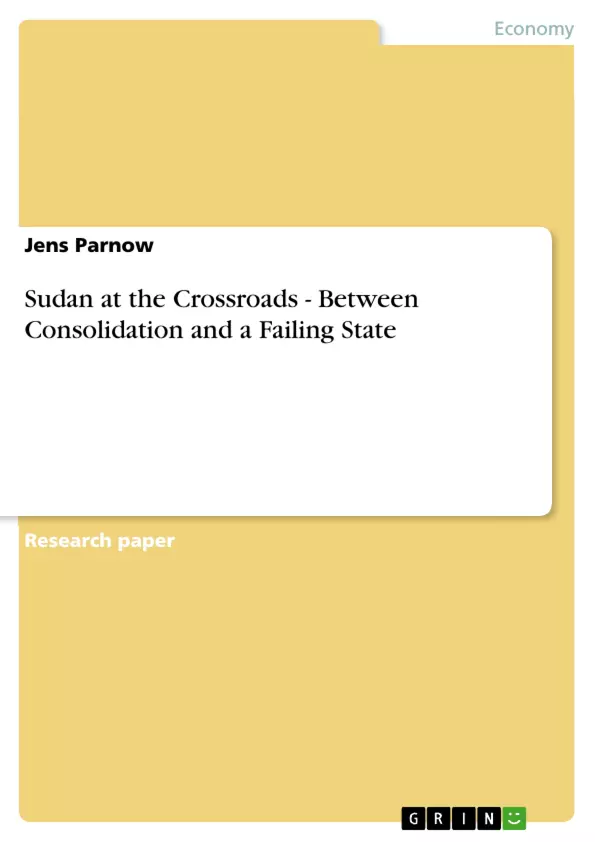The recent Darfur crisis and the humanitarian catastrophe have put some public view on the Sudan. Voices to intervene have been raised and quick connections to the massacres in Rwanda in 1994 are made. The fact that the Sudanese people have been suffering from almost 40 years of intermitted civil war seems to play at best an inferior role. Despite the neglect by a vast majority of the public the southern regions are just recovering from devastating civil war and peace is still fragile. The transition to a democratic system is far from being realized, droughts have increased nutrition problems in the South and the revenues from economic growth are distributed very unevenly. In addition to these problems, neighbouring states are either dictatorships with rivalling interests, in a period of uncertain transition or former stable states such as Chad and Kenya which are tumbling towards domestically crisis.
Nevertheless to understand the aims of the opposing actors and how these conflicts were able to develop it is necessary to have a close look on Sudan’s recent past. The essay covers Sudan’s way from a British colony to its independence, followed and accompanied by two severe civil wars and their reasons up to the Darfur crisis today. In the second part the author analyses the aims of the different, local, national and international actors and assesses reasonable strategies for a lasting peace in Sudan. The leading thoughts in this essay are expressed by the main questions: How did the Sudanese civil wars, which culminated in the recent Darfur crisis, evolve? What would be a reasonable
strategy to secure a stable peace in Sudan? The author wants to emphasize the necessity to bring Sudan to a stable peace. As the
biggest country in Africa this could contribute to stability in the whole eastern African region, preventing humanitarian crisis and agony. Hasty decision derived from compassion and quick accusations without the necessary background may lead to false directions. This analysis shall provide objective evidence about the current situation and is intended to contribute to a wider comprehension among students of international politics.
Inhaltsverzeichnis (Table of Contents)
- Abbreviations
- Introduction
- Scientific Approach
- Historic Background
- From Independence to Civil War 1955 - 1972
- The Second Civil War 1983-2005
- Darfur Crisis 2003 - Present time
- Actors and Strategies
- The Comprehensive Peace Agreement
- John Garang and the SPLM/A
- Salva Kiir
- Omar al-Bashir and the National Islamic Front
- Peace efforts by IGAD
- Strategic interests
- United Nations
- Internal opposition in the North and South
- Sudan at the Crossroads
- Consolidating Peace in the South
- Peace Enforcement in Darfur
- Conclusion
Zielsetzung und Themenschwerpunkte (Objectives and Key Themes)
This essay examines the complex history of Sudan's civil wars and their evolution into the Darfur crisis. It aims to provide a comprehensive understanding of the conflict's roots, the motivations and strategies of the actors involved, and potential pathways towards lasting peace. Key themes explored include:- The historical context of Sudan's independence and the subsequent civil wars, focusing on the South.
- The role of different actors, both local, national, and international, in shaping the conflict.
- The challenges of consolidating peace in the South and enforcing peace in Darfur.
- The applicability of state building theory and human security concepts, particularly Mary Kaldor's cosmopolitan approach, to the Sudanese context.
- The potential for Sudan's conflicts to serve as examples of "New Wars" and the need for adjusted strategies to achieve lasting peace.
Zusammenfassung der Kapitel (Chapter Summaries)
This section provides a summary of the chapters, excluding the conclusion.- Introduction: This chapter introduces the current situation in Sudan, highlighting the Darfur crisis and its connection to the long history of civil war. It emphasizes the need for a nuanced understanding of the conflict and the importance of a stable peace in Sudan.
- Scientific Approach: This section outlines the methodological approach employed in the essay. It emphasizes the use of historical facts, contemporary accounts, and theoretical frameworks, particularly focusing on Mary Kaldor's cosmopolitan approach to state building and human security.
- Historic Background: This chapter delves into the historical context of Sudan's independence, focusing on the period from 1955-1972. It examines the factors that led to the first civil war, including the challenges of achieving independence and the rivalry between the North and the South.
- The Second Civil War 1983-2005: This chapter explores the second civil war in Sudan, highlighting its causes, key actors, and the devastating impact on the country. It emphasizes the role of political and religious tensions in escalating the conflict.
- Darfur Crisis 2003 - Present time: This chapter examines the Darfur crisis, focusing on its origins, the humanitarian crisis it has caused, and the involvement of international actors. It explores the motivations behind the conflict and the challenges of achieving a lasting resolution.
- Actors and Strategies: This chapter analyzes the motivations and strategies of different actors involved in the Sudanese conflict, including the Sudanese government, rebel groups, regional organizations, and international powers. It examines their roles in shaping the conflict and their potential for influencing a peaceful resolution.
- Sudan at the Crossroads: This chapter explores the challenges and opportunities facing Sudan as it seeks to build peace. It examines the potential for consolidating peace in the South and enforcing peace in Darfur. It also discusses the challenges of achieving a lasting peace in Sudan and the need for a comprehensive and sustainable approach.
Schlüsselwörter (Keywords)
The essay examines the complex political and social dynamics of Sudan, focusing on the history of civil wars and the contemporary challenges of building peace. Key terms include: Sudan, civil war, Darfur, South Sudan, peacebuilding, state building, human security, Mary Kaldor, New Wars, actors, strategies, and international intervention.- Citation du texte
- Dipl. Volkswirt Jens Parnow (Auteur), 2008, Sudan at the Crossroads - Between Consolidation and a Failing State, Munich, GRIN Verlag, https://www.grin.com/document/139427



